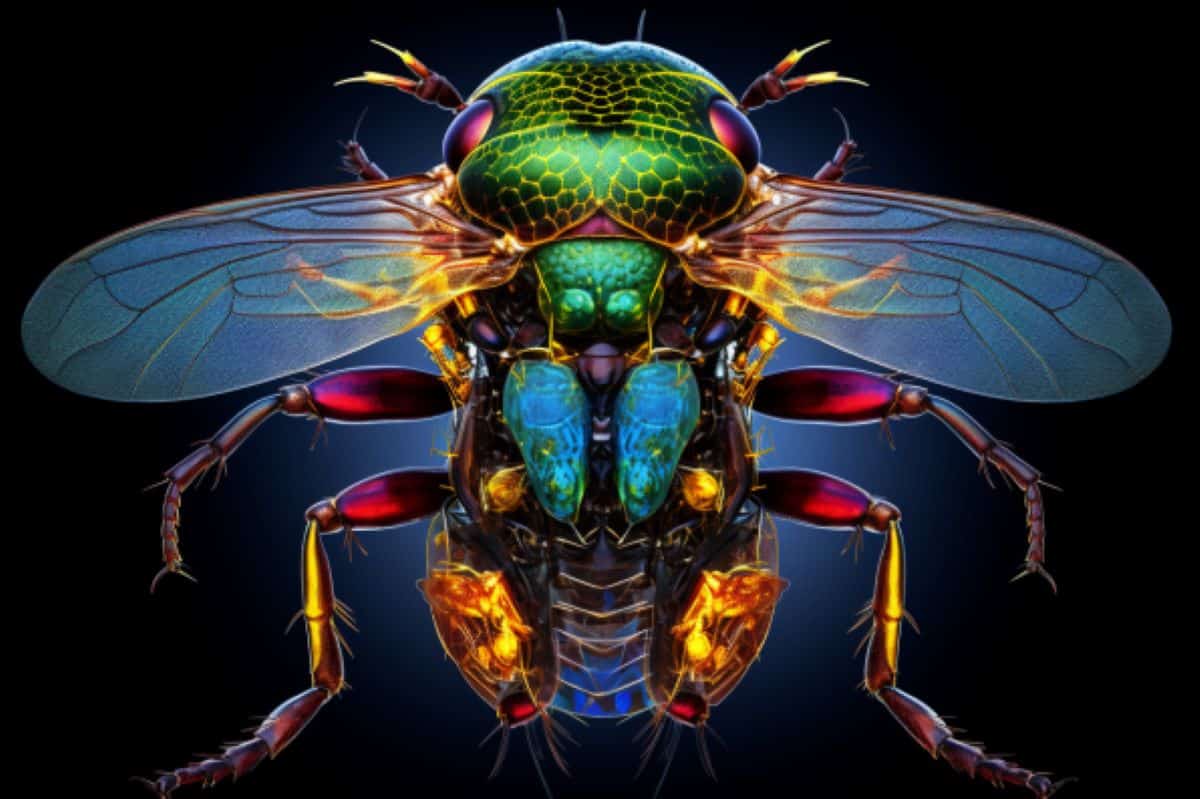Summary: The mushroom body—a key area in the brains of arthropods like insects—plays a crucial role in abstract behavioral decision-making.
Contrary to the long-standing belief that insects react purely on stimulus-response, the study shows they can actually make nuanced decisions based on experiences. The researchers recorded feeding behavior alongside neural signals.
This has implications for understanding not just insect behavior but also basic neurobiological principles that are similar in humans.
Key Facts:
- The mushroom body in arthropod brains encodes for both memory formation and complex decision-making, contesting prior views that insects operate merely on a stimulus-response basis.
- The research involved the American cockroach, chosen for its relatively large brain, making it easier to measure and interpret neural signals and behavior in real-time.
- The output neurons of the mushroom body also take into account the current state of the animal, like whether it is hungry, enabling more precise prediction of behavior.
Source: University of Cologne
The mushroom body – the learning and memory region in the brains of arthropods – is responsible for the ability of insects to make abstract behavioural decisions, which are then carried out by downstream motor networks.
That is the result of a study conducted by Professor Dr Martin Paul Nawrot and Dr Cansu Arican from the ‘Computational Systems Neuroscience’ working group at the University of Cologne’s Institute of Zoology.
The research was reported in Current Biology under the title ‘The mushroom body output encodes behavioural decision during sensory-motor transformation’.

For a long time, the prevailing view among researchers had been that insects react in a robotic manner according to simple stimulus-response patterns, but this assumption has changed greatly over the past two decades: “Insects have simple cognitive skills such as memory formation and recall as well as experience-dependent decision making. Despite their comparatively small brains, they exhibit complex behavioural patterns,” said Professor Nawrot.
In invertebrate insects and mammals – and thus also humans – the necessary processes of the nervous system follow similar basic principles in many respects. This includes a rapid sensory processing of environmental conditions and their evaluation, a comparison with acquired experience (and accordingly a reliable decision between possible options of behaviour) and ultimately the physical execution of a behavioural sequence.
15 years of research on a brain circuit
An important processing region in the central brain of the insect, known as mushroom body due to its anatomical shape, is crucial for the formation of memory. In the last 15 years, various research endeavours have shown that memory information is encoded by the valence of a sensory stimulus at the output of the mushroom body.
Within the framework of the research group FOR 2705 ‘Dissection of a Brain Circuit: Structure, Plasticity and Behavioral Function of the Drosophila Mushroom Body’, which has been funded by the German Research Foundation since 2018, the Cologne team led by Professor Nawrot is also contributing to this research field.
Insects determine whether a certain stimulus has previously been memorized as positive (for example, a scent that promises food) or as negative (for example, a scent of pathogenic substances such as harmful bacteria in the food).
Recent studies have also shown that the output neurons of the mushroom body also evaluate sensory stimuli that are relevant for innate behaviour, i.e. behaviour not based on experience.
Description of a new function of the mushroom body
In this latest study, lead author Dr Cansu Arican describes how she measured the activity of the output neurons of the mushroom body in the American cockroach (Periplaneta americana) in her experiments, at the same time filming the feeding behaviour of the animals.
This large insect species was chosen because it has a much larger brain than the fruit fly Drosophila, which often serves as a model organism in basic research.
This allowed for the electronic measurement of neuronal signals, making it possible to simultaneously measure and interpret both the stimulus activity with different food odours and the neuronal responses in the mushroom body – and ultimately the animal’s feeding behaviour – as a possible behavioural response to the stimulus with high temporal precision.
The research team observed that the mushroom body output neurons not only encode the valence of a particular odour, for example the odour of food compared to a neutral odour, they also form a decision on the execution of the respective feeding behaviour based on this information.
They make the behavioural decision not only on the basis of the information of this valence; the current state of the animal is also important, for example whether it is hungry or not at that moment. In the respective trial and on the basis of the neural response pattern, it was thus possible to accurately predict whether the animal would show the feeding behaviour only about a tenth of a millisecond later.
Similar to the motor areas of the cerebral cortex in the human brain, the mushroom body thus makes a first behavioural decision and sends an abstract motor command to the downstream motor network – in the case of humans, this is the spinal cord – which then executes the behaviour by activating the relevant muscles.
“This result contests the prevailing view of the mushroom body, which can now be seen as a centre for memory formation and behavioural decision-making. This is important because research on insect brains is also relevant for understanding the function of more complex brains,” Dr Cansu Arican summed up the results.
Funding: The study was supported by funding from the German Research Foundation and the “iBehave” network.
About this neuroscience research news
Author: Anna Euteneuer
Source: University of Cologne
Contact: Anna Euteneuer – University of Cologne
Image: The image is credited to Neuroscience News
Original Research: Open access.
“The mushroom body output encodes behavioral decision during sensory-motor transformation” by Martin Paul Nawrot et al. Current Biology
Abstract
The mushroom body output encodes behavioral decision during sensory-motor transformation
Highlights
- Simultaneous recording of mushroom body output neurons (MBONs) and behavior
- Innate feeding behavior is exclusively expressed in response to food odors
- MBONs respond almost exclusively during behavioral trials and with short latency
- MBON responses allow for the faithful prediction of behavior in the single trial
Summary
Animals form a behavioral decision by evaluating sensory evidence on the background of past experiences and the momentary motivational state. In insects, we still lack understanding of how and at which stage of the recurrent sensory-motor pathway behavioral decisions are formed.
The mushroom body (MB), a central brain structure in insects and crustaceans, integrates sensory input of different modalities with the internal state, the behavioral state, and external sensory context through a large number of recurrent, mostly neuromodulatory inputs, implicating a functional role for MBs in state-dependent sensory-motor transformation.
A number of classical conditioning studies in honeybees and fruit flies have provided accumulated evidence that at its output, the MB encodes the valence of a sensory stimulus with respect to its behavioral relevance. Recent work has extended this notion of valence encoding to the context of innate behaviors.
Here, we co-analyzed a defined feeding behavior and simultaneous extracellular single-unit recordings from MB output neurons (MBONs) in the cockroach in response to timed sensory stimulation with odors. We show that clear neuronal responses occurred almost exclusively during behaviorally responded trials.
Early MBON responses to the sensory stimulus preceded the feeding behavior and predicted its occurrence or non-occurrence from the single-trial population activity.
Our results therefore suggest that at its output, the MB does not merely encode sensory stimulus valence. We hypothesize instead that the MB output represents an integrated signal of internal state, momentary environmental conditions, and experience-dependent memory to encode a behavioral decision.







